News and Site Updates Archive 2010/04/15
The only completely consistent people are dead.
– Aldous Huxley
15 Apr '10 - I recently switched to a table format for my homepage so that it could be read with a PDA. I now realise that, considering table padding,
table and image borders, and the fact that browsers snatch a varied number of pixels for their own use, I usually overran the nominal width of 1,024 (effectively much smaller, as I've learned) on at least one
line. This meant that, for most people with standard monitors, the screen would wrap, making reading this page a pain. For that I apologise. This problem was finally brought to my
attention by a really nice visitor (one with his own blog) and I've since attempted to correct it. I'm still working on it. If I try
something new that makes reading this page more annoying, consider letting me know. Also, if you have an opinion as to whether
it would be better for me to make shorter, weekly posts or continue with longer, semi-monthly posts,
tell me (otherwise, I'll just do as I please).
 More than 125,000 years ago, your ancestors discovered fire. With it came a source of heat, warmth, and light. For 1 in 3 people living today, unfortunately, little
has changed. This is energy poverty. Let that sink in: This
describes 1/3 of the world’s population. While the rich North mulls which light bulbs to buy, the poor South — particularly vast stretches of sub-Saharan Africa — toils in the dark. These kids
(only boys are visible, pointing to another glaring challenge) are so motivated to learn and build productive lives that they’re willing to hike to a parking lot to do their homework. These Guinean
students are studying under the lights located at the nearby Conakry Airport parking lot. More than 125,000 years ago, your ancestors discovered fire. With it came a source of heat, warmth, and light. For 1 in 3 people living today, unfortunately, little
has changed. This is energy poverty. Let that sink in: This
describes 1/3 of the world’s population. While the rich North mulls which light bulbs to buy, the poor South — particularly vast stretches of sub-Saharan Africa — toils in the dark. These kids
(only boys are visible, pointing to another glaring challenge) are so motivated to learn and build productive lives that they’re willing to hike to a parking lot to do their homework. These Guinean
students are studying under the lights located at the nearby Conakry Airport parking lot.
 "When he tired of official reports and memoranda and minutes, he plugged his foolscap-sized Newspad into the ship's information circuit and scanned the latest reports from
Earth. One by one he conjured up the world's major electronic papers. Switching to the display unit's short-term memory, he held the front page while he quickly searched the headlines and noted
items that interested him. The postage-stamp-sized rectangle expanded until it neatly filled the screen and he could read it with comfort. When he finished, he flashed back to the complete page
and selected a new subject for detailed examination. One could spend an entire lifetime doing nothing but absorbing the ever-changing flow of information from news satellites." - from 2001: A Space Odyssey / Arthur C Clarke, 1968 "When he tired of official reports and memoranda and minutes, he plugged his foolscap-sized Newspad into the ship's information circuit and scanned the latest reports from
Earth. One by one he conjured up the world's major electronic papers. Switching to the display unit's short-term memory, he held the front page while he quickly searched the headlines and noted
items that interested him. The postage-stamp-sized rectangle expanded until it neatly filled the screen and he could read it with comfort. When he finished, he flashed back to the complete page
and selected a new subject for detailed examination. One could spend an entire lifetime doing nothing but absorbing the ever-changing flow of information from news satellites." - from 2001: A Space Odyssey / Arthur C Clarke, 1968
 From Ketcham and Kelly's Google, Cloud Computing and the Surveillance-Industrial Complex: "Google controls an estimated 70% of the online search engine market, but its
deep-drilling of user information – where we surf, whom we email, on what blogs we post, what pictures we share, what maps we view, what news we read – extends far beyond that to encompass the 'total
information awareness' that privacy activists fear. At the extreme, your every move can be tracked by some feature of Google. In all of human history, who has ever possessed such a hoard of sensitive data about so many people? Yet here, the Fourth Amendment’s
protections against search and seizure don't apply. And Google works with top players in the surveillance industry, notably Lockheed-Martin and SRA International." From Ketcham and Kelly's Google, Cloud Computing and the Surveillance-Industrial Complex: "Google controls an estimated 70% of the online search engine market, but its
deep-drilling of user information – where we surf, whom we email, on what blogs we post, what pictures we share, what maps we view, what news we read – extends far beyond that to encompass the 'total
information awareness' that privacy activists fear. At the extreme, your every move can be tracked by some feature of Google. In all of human history, who has ever possessed such a hoard of sensitive data about so many people? Yet here, the Fourth Amendment’s
protections against search and seizure don't apply. And Google works with top players in the surveillance industry, notably Lockheed-Martin and SRA International."
Data Protection Laws Around the World
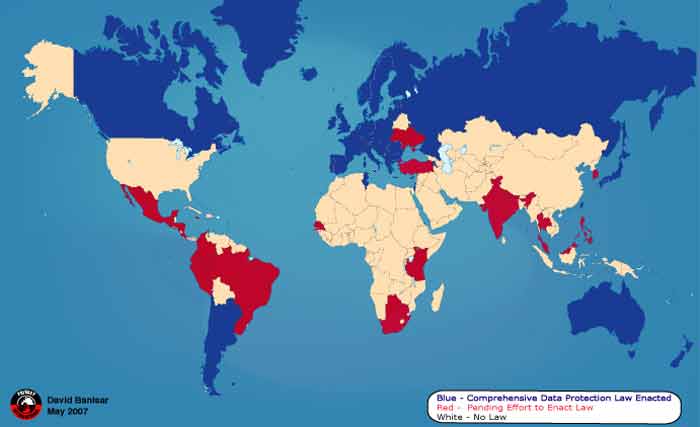
Privacy protection is frequently seen as a way of drawing the line at how far society can intrude into a person's affairs. Privacy
International is a human rights group formed in 1990 as a watchdog on surveillance and privacy invasions. It is based in London and has an office in Washington DC. The group campaigns to protect
people against intrusion by governments and corporations that seek to erode the right to privacy, believing that privacy forms part of the bedrock of freedoms. What with anti-terrorism laws, border and
travel surveillance, closed-circuit cameras, financial and communications surveillance, and even genetic databanks, privacy appears to lose ground each year.
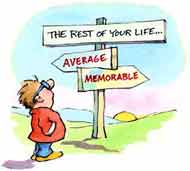 The
relationship between happiness and income is complicated and, after a point, tenuous. It's true that poor nations become happier as they become middle-class nations. But once basic necessities
have been achieved, future income only lightly connects to well-being. Winning the lottery doesn’t seem to produce lasting gains in well-being nor are people happiest during years when they're winning
the most promotions. Instead, people are happy in their 20s, dip in middle age and then, on average, hit peak happiness just after retirement at age 65. But if the relationship between money and
well-being is complicated, correspondence between personal relationships and happiness is not. Daily activities most associated with happiness are sex, socialising after work and having dinner with
others. The daily activity most injurious to happiness is commuting. Joining a group that meets even just once a month produces the same happiness gain as doubling income. Being married
produces a psychic gain equivalent to more than $100,000 a year. Want to find a good place to live? Just ask people if they trust their neighbours. Countries with high social trust have
happier people, better health, more efficient government, more economic growth, and less fear of crime (regardless of whether actual crime rates are increasing or decreasing). This article states that
"...modern societies have a primordial fear of moral and social [concerns]" but they don't really prove the point. And, if you make more than $100k a year, a monthly group means more than your
spouse? Then why bother to marry? Join 2 or 3 groups! Though, frankly, I'd rather have the money instead.) The
relationship between happiness and income is complicated and, after a point, tenuous. It's true that poor nations become happier as they become middle-class nations. But once basic necessities
have been achieved, future income only lightly connects to well-being. Winning the lottery doesn’t seem to produce lasting gains in well-being nor are people happiest during years when they're winning
the most promotions. Instead, people are happy in their 20s, dip in middle age and then, on average, hit peak happiness just after retirement at age 65. But if the relationship between money and
well-being is complicated, correspondence between personal relationships and happiness is not. Daily activities most associated with happiness are sex, socialising after work and having dinner with
others. The daily activity most injurious to happiness is commuting. Joining a group that meets even just once a month produces the same happiness gain as doubling income. Being married
produces a psychic gain equivalent to more than $100,000 a year. Want to find a good place to live? Just ask people if they trust their neighbours. Countries with high social trust have
happier people, better health, more efficient government, more economic growth, and less fear of crime (regardless of whether actual crime rates are increasing or decreasing). This article states that
"...modern societies have a primordial fear of moral and social [concerns]" but they don't really prove the point. And, if you make more than $100k a year, a monthly group means more than your
spouse? Then why bother to marry? Join 2 or 3 groups! Though, frankly, I'd rather have the money instead.)
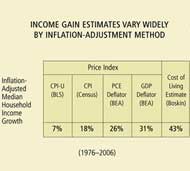 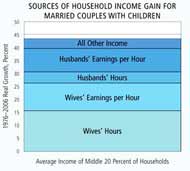 The US has the highest level of inequality of the highly industrialised countries, based on data available in 2008. Ranked slightly
more unequal than Sri Lanka and on a par with Ghana and Turkmenistan, since 1980 the richest Americans' incomes quadrupled while the lowest 90% fell. Average wage is lower today than in the 1970s, yet
productivity rose almost 50%. In 1983, middle class debt was 67% of income. In 2007, it was 157%. In 1950 the ratio of the average executive's pay to the average worker was about 30 to
1. Since 2000 it ranges from 300-500 to 1. Between 1978 and 2008, a third of America's total income growth went to the top 1/10 of 1%. However, not everyone agrees that things are so bad. Individual workers and households stagnated while the national economy
grew robustly? How can microeconomic data on individual wages / household income and macroeconomic statistics covering the national economy lead to such different conclusions? A
nation is comprised of individuals, so these statistics seem incompatible. Economists offer competing explanations for the apparent dichotomy. One: huge economic gains made by prosperous Americans
drove the large average increases reported in national statistics while middle America stagnated. Average income bumps up when people like Bill Gates get even richer, but it has virtually no impact on
the median. An alternative explanation argues that microeconomic statistics paint an inaccurate picture of middle America gains - the affluent alone can't account for such substantial
growth. Microeconomic statistics showing stagnation and macroeconomic statistics exhibiting growth merely measure "wages" differently. Adjust data to measure the same thing and the disparity
largely evaporates; hourly labour income for middle America did NOT stagnate but rose significantly over the past 30 years. Fringe benefits became increasingly important, currently accounting
for 30% of employer costs for compensation. Nevertheless, hourly wages at the 90th and 95th percentiles rose more than 40% from 1975 to 2005, twice the growth in the median wage (20%) - therefore
inequality IS growing. Also to consider: average annual working hours of wives almost doubled between 1976
and 2006 and there has also been a change in the mix of household types and in the choice of how to compute the price
index. Inflation-adjusted median household income for most household types increased by 44 - 62% from 1976 to 2006. (Quite a range of positions there. Believe what you like.) The US has the highest level of inequality of the highly industrialised countries, based on data available in 2008. Ranked slightly
more unequal than Sri Lanka and on a par with Ghana and Turkmenistan, since 1980 the richest Americans' incomes quadrupled while the lowest 90% fell. Average wage is lower today than in the 1970s, yet
productivity rose almost 50%. In 1983, middle class debt was 67% of income. In 2007, it was 157%. In 1950 the ratio of the average executive's pay to the average worker was about 30 to
1. Since 2000 it ranges from 300-500 to 1. Between 1978 and 2008, a third of America's total income growth went to the top 1/10 of 1%. However, not everyone agrees that things are so bad. Individual workers and households stagnated while the national economy
grew robustly? How can microeconomic data on individual wages / household income and macroeconomic statistics covering the national economy lead to such different conclusions? A
nation is comprised of individuals, so these statistics seem incompatible. Economists offer competing explanations for the apparent dichotomy. One: huge economic gains made by prosperous Americans
drove the large average increases reported in national statistics while middle America stagnated. Average income bumps up when people like Bill Gates get even richer, but it has virtually no impact on
the median. An alternative explanation argues that microeconomic statistics paint an inaccurate picture of middle America gains - the affluent alone can't account for such substantial
growth. Microeconomic statistics showing stagnation and macroeconomic statistics exhibiting growth merely measure "wages" differently. Adjust data to measure the same thing and the disparity
largely evaporates; hourly labour income for middle America did NOT stagnate but rose significantly over the past 30 years. Fringe benefits became increasingly important, currently accounting
for 30% of employer costs for compensation. Nevertheless, hourly wages at the 90th and 95th percentiles rose more than 40% from 1975 to 2005, twice the growth in the median wage (20%) - therefore
inequality IS growing. Also to consider: average annual working hours of wives almost doubled between 1976
and 2006 and there has also been a change in the mix of household types and in the choice of how to compute the price
index. Inflation-adjusted median household income for most household types increased by 44 - 62% from 1976 to 2006. (Quite a range of positions there. Believe what you like.)
 Noted science-fiction author Philip Kindred Dick and his twin sister, Jane
Charlotte Dick, were born 6
weeks prematurely in Chicago. Dick's father, a fraud investigator for the US Department of Agriculture, had recently taken out life insurance policies on the family. An insurance nurse was
dispatched to the Dick household. Upon seeing the malnourished Philip and injured Jane, the nurse rushed the babies to hospital. Baby Jane died en route, just 5 weeks after her birth. The
death of Philip's twin sister profoundly affected his writing, relationships, and every aspect of his life, leading to the recurrent motif of the "phantom twin" in many of his books. Philip was an old hand at marital dissolution. His wife, Tessa, had reached her breaking
point, and one evening in 1976 marked the beginning of what would become his 5th divorce. The author could bounce in and out of love affairs, stints in rehab and drug overdoses - all the while never
losing his cool. This time, though, the nonchalance wouldn't last. That night, Dick took 49 tablets prescribed for a heart condition, along with other pills. He slashed his wrist and sat in
his car, parked in his garage, so the carbon monoxide would finish him off. But he threw up the pills and his car stalled. The blood from his wrist clotted. After a quick stay in the hospital
and a fortnight in a psychiatric ward, Dick went home. He went on to write many of his more famous novels, including A Scanner Darkly. Dick died in Santa Ana, California, on 2 March
1982. He had suffered a stroke 5 days earlier and was disconnected from life support after his EEG remained consistently flat. After his death, his father took his ashes to Fort Morgan,
Colorado. Twin sister Jane's tombstone had both their names carved on it, with an empty space for Dick's death date - so brother and sister were eventually buried next to each other. (A lot seems
left unsaid here. Like, who injured Jane? Who starved Philip? What impact might gross malnourishment at such a young age have had on his life?) Noted science-fiction author Philip Kindred Dick and his twin sister, Jane
Charlotte Dick, were born 6
weeks prematurely in Chicago. Dick's father, a fraud investigator for the US Department of Agriculture, had recently taken out life insurance policies on the family. An insurance nurse was
dispatched to the Dick household. Upon seeing the malnourished Philip and injured Jane, the nurse rushed the babies to hospital. Baby Jane died en route, just 5 weeks after her birth. The
death of Philip's twin sister profoundly affected his writing, relationships, and every aspect of his life, leading to the recurrent motif of the "phantom twin" in many of his books. Philip was an old hand at marital dissolution. His wife, Tessa, had reached her breaking
point, and one evening in 1976 marked the beginning of what would become his 5th divorce. The author could bounce in and out of love affairs, stints in rehab and drug overdoses - all the while never
losing his cool. This time, though, the nonchalance wouldn't last. That night, Dick took 49 tablets prescribed for a heart condition, along with other pills. He slashed his wrist and sat in
his car, parked in his garage, so the carbon monoxide would finish him off. But he threw up the pills and his car stalled. The blood from his wrist clotted. After a quick stay in the hospital
and a fortnight in a psychiatric ward, Dick went home. He went on to write many of his more famous novels, including A Scanner Darkly. Dick died in Santa Ana, California, on 2 March
1982. He had suffered a stroke 5 days earlier and was disconnected from life support after his EEG remained consistently flat. After his death, his father took his ashes to Fort Morgan,
Colorado. Twin sister Jane's tombstone had both their names carved on it, with an empty space for Dick's death date - so brother and sister were eventually buried next to each other. (A lot seems
left unsaid here. Like, who injured Jane? Who starved Philip? What impact might gross malnourishment at such a young age have had on his life?)
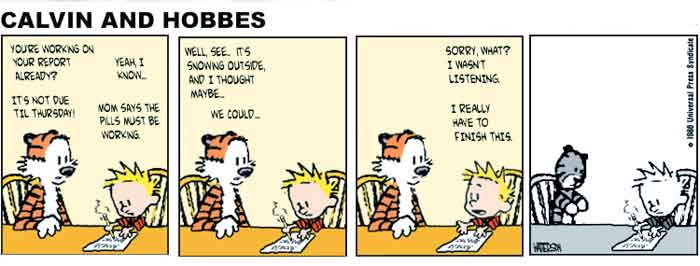
 Using archaeological and other evidence, researchers
have in recent years
pieced together a complex picture of Vikings that sharply contradicts their stereotype as mere barbarians. The Norsemen were warriors, but also farmers, artists, shipbuilders, and
innovators. More than anything, they were excellent traders who connected peoples from Baghdad to Scandinavia to the mainland of North America. Viking is misused as an ethnic term - the
Vikings belonged to the upper class. They were the sea warriors - but most people were just Scandinavians. For them, the normal life was to stay home and farm. In letters to their bishops,
Christian priests in Britain and France chronicled violent deeds of Vikings, which included attacking wealthy monasteries and killing women and children. But it was a ruthless age. It was in the
interest of churchmen to exaggerate the atrocities of Vikings. Many Christian rulers at the time behaved equally unpleasantly. (51 headless Vikings were recently found in a 1,000-year-old execution pit in southern England near
Weymouth.) Viking society was extremely unequal. Slavery was a fundamental contributor to the wealth of the upper class and Vikings participated actively in the lucrative slave trade
abroad. Slaves had no rights and were owned like cattle - but the Scandinavians did have a highly developed legal system, perhaps the most democratic in the known world. Decisions were reached by
voting at open meetings where all free men had the right to speak. Women also had substantial powers: they could own land, inherit, and divorce. Well travelled, the Vikings assimilated into new
cultures, abandoning many of their own practices. Viking marauders of ill-gotten gains thus became the ancestors of royalty and noblesse in
Europe and Great Britain. Using archaeological and other evidence, researchers
have in recent years
pieced together a complex picture of Vikings that sharply contradicts their stereotype as mere barbarians. The Norsemen were warriors, but also farmers, artists, shipbuilders, and
innovators. More than anything, they were excellent traders who connected peoples from Baghdad to Scandinavia to the mainland of North America. Viking is misused as an ethnic term - the
Vikings belonged to the upper class. They were the sea warriors - but most people were just Scandinavians. For them, the normal life was to stay home and farm. In letters to their bishops,
Christian priests in Britain and France chronicled violent deeds of Vikings, which included attacking wealthy monasteries and killing women and children. But it was a ruthless age. It was in the
interest of churchmen to exaggerate the atrocities of Vikings. Many Christian rulers at the time behaved equally unpleasantly. (51 headless Vikings were recently found in a 1,000-year-old execution pit in southern England near
Weymouth.) Viking society was extremely unequal. Slavery was a fundamental contributor to the wealth of the upper class and Vikings participated actively in the lucrative slave trade
abroad. Slaves had no rights and were owned like cattle - but the Scandinavians did have a highly developed legal system, perhaps the most democratic in the known world. Decisions were reached by
voting at open meetings where all free men had the right to speak. Women also had substantial powers: they could own land, inherit, and divorce. Well travelled, the Vikings assimilated into new
cultures, abandoning many of their own practices. Viking marauders of ill-gotten gains thus became the ancestors of royalty and noblesse in
Europe and Great Britain.
 Colonel Lawrence Wilkerson, a top aide to Colin Powell when he was Secretary of State, in a signed declaration in support of a Guantánamo
detainee who is suing the
US government, has stated that President
George Bush, Vice President Dick Cheney and Secretary of Defense Donald Rumsfeld all "knew" that many of the detainees at Guantánamo were innocent. Wilkerson also stated that Cheney and Rumsfeld did
not want the detained to be released since it would reveal how confused and disorganised the terrorist detention operation was. Domestically, Obama has continued to allow the policy of detention without trial of hundreds of captives in Guantánamo Bay and other prisons, including Bagram
Airbase in Afghanistan, and his director of national security has even stated that it is the policy of this administration that American citizens deemed by the administration to be enemy combatants or
terrorists may be targeted for summary execution. Such officially sanctioned state murder is a blatant violation of the Constitution’s insistence that every American has a right to a presumption of
innocence and to a trial by a jury of his or her peers. President Obama has ordered the murder of American citizen Anwar
al-Awlaki. Like the innocent but tortured Abu Zubayda (innocent at least of any of the crimes he was accused of), Awlaki is now the mastermind terrorist of the universe. And once he's dead,
who's to say he wasn't? Who can demand a trial or access to documents? He'll be dead - see the beauty of it? Also, if the top mastermind is in Yemen, what are we doing building such a
quagmire in Afghanistan? Oh, wait - don't ask that... Colonel Lawrence Wilkerson, a top aide to Colin Powell when he was Secretary of State, in a signed declaration in support of a Guantánamo
detainee who is suing the
US government, has stated that President
George Bush, Vice President Dick Cheney and Secretary of Defense Donald Rumsfeld all "knew" that many of the detainees at Guantánamo were innocent. Wilkerson also stated that Cheney and Rumsfeld did
not want the detained to be released since it would reveal how confused and disorganised the terrorist detention operation was. Domestically, Obama has continued to allow the policy of detention without trial of hundreds of captives in Guantánamo Bay and other prisons, including Bagram
Airbase in Afghanistan, and his director of national security has even stated that it is the policy of this administration that American citizens deemed by the administration to be enemy combatants or
terrorists may be targeted for summary execution. Such officially sanctioned state murder is a blatant violation of the Constitution’s insistence that every American has a right to a presumption of
innocence and to a trial by a jury of his or her peers. President Obama has ordered the murder of American citizen Anwar
al-Awlaki. Like the innocent but tortured Abu Zubayda (innocent at least of any of the crimes he was accused of), Awlaki is now the mastermind terrorist of the universe. And once he's dead,
who's to say he wasn't? Who can demand a trial or access to documents? He'll be dead - see the beauty of it? Also, if the top mastermind is in Yemen, what are we doing building such a
quagmire in Afghanistan? Oh, wait - don't ask that...
 The Obama administration has apparently decided that it possesses the legal authority to order the extra-judicial killing of American citizen and
possible al-Qaeda affiliate
Anwar al-Awlaki (Aulaqi). Karen Greenberg, director of New York University’s Center on Law and Security feels that the government can’t just revoke al-Awlaki’s citizenship and views a potential
assassination of the Yemen-based cleric as a looming national security
blunder. Chances are whatever determination that al-Awlaki has crossed the line from inciting terrorist plots to participating in them came from the interrogation of Umar Farouk Abdulmutallab - which
occurred with the full protections of Miranda rights under the US criminal justice system. Abdulmutallab, of course, isn’t a citizen and al-Awlaki is. Apparently, the Department of Justice, the
White House and the Central Intelligence Agency have all declined to provide any documentation determining the legal basis for extra-judicial killing of any American citizen on counterterrorism
grounds. I cannot, of course, comment with first-hand knowledge on the guilt or innocence of al-Awlaki. But I do think there are better ways than issuing the modern-day equivalent of a "Wanted:
Dead or Alive" poster to deal with this problem. The Obama administration has apparently decided that it possesses the legal authority to order the extra-judicial killing of American citizen and
possible al-Qaeda affiliate
Anwar al-Awlaki (Aulaqi). Karen Greenberg, director of New York University’s Center on Law and Security feels that the government can’t just revoke al-Awlaki’s citizenship and views a potential
assassination of the Yemen-based cleric as a looming national security
blunder. Chances are whatever determination that al-Awlaki has crossed the line from inciting terrorist plots to participating in them came from the interrogation of Umar Farouk Abdulmutallab - which
occurred with the full protections of Miranda rights under the US criminal justice system. Abdulmutallab, of course, isn’t a citizen and al-Awlaki is. Apparently, the Department of Justice, the
White House and the Central Intelligence Agency have all declined to provide any documentation determining the legal basis for extra-judicial killing of any American citizen on counterterrorism
grounds. I cannot, of course, comment with first-hand knowledge on the guilt or innocence of al-Awlaki. But I do think there are better ways than issuing the modern-day equivalent of a "Wanted:
Dead or Alive" poster to deal with this problem.

As a Hindu saying puts it, "Raising a daughter is like watering your neighbours’ garden."
China in 2020 will have 30 - 40 million more men aged 19 and below than young women. For
comparison, there are 23 million boys below the age of 20 in Germany, France and Britain combined and around 40 million American boys and young men. So within 10 years, China faces the prospect of having
the equivalent of the whole young male population of America, or almost twice that of Europe’s 3 largest countries, with little prospect of marriage, untethered to a home of their own and without the stake in
society that marriage and children provide. The war against baby girls is not confined to China - parts of India have sex ratios as skewed. Other East Asian countries — South Korea, Singapore
and Taiwan — have peculiarly high numbers of male births. So, since the collapse of the Soviet Union, have former communist countries in the Caucasus and western Balkans. Even subsets of
America’s population are following suit, though not the population as a whole. The real cause is not any country’s particular policy but "the fateful collision between overweening son preference, the
use of rapidly spreading prenatal sex-determination technology, and declining fertility." These are global trends. And the selective destruction of baby girls is global, too. Not all
traditional societies show a marked preference for sons over daughters. But in those that do — especially those in which the family line passes through the son and in which he is supposed to look after
his parents in old age — a son is worth more. A girl is deemed to have joined her husband’s family on marriage, and is lost to her parents. Speculation is rampant about what might happen: a
war to cull the surplus males, a rise in crime, a huge expansion in prostitution (already a major industry in every Chinese city), a rise in homosexuality. This is for sure: it cannot now be prevented,
and it is already beginning to be obvious in the schools. It is also stimulating a miserable trade in stolen children. One academic source has suggested that there could be a ratio of 168 males for
every 100 girls in Danzhou. Something is clearly out of kilter. In one class of 10-year-olds, only 20 out of 80 were girls. In another classroom, it was 25 out of 63. In Kunming, an
outwardly civilised university city of 6 million people, 6,000 feet up on a high plateau, one of the many posters for medical services advertises what it calls a "dream abortion - totally painless", which
makes one wonder what the considerably cheaper non-dream versions must be like. Someone asked the abortionist if he ever aborts boys. He gaped. "Are you mad?" he almost shouted, "Nobody
aborts boys unless they're deformed." Actually, it's surprising that as many girls survive as do.
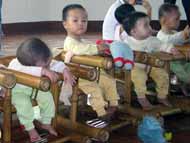 In some countries, there may be whole generations in which a majority of people suffer from
the inability to bond. Orphanages are full
of traumatised kids who have never learned to love, kids who are so angry and afraid that they're unable to survive in a family. Many of these kids, suffering from reactive attachment disorder, could be
healed, but only at great cost and with an extreme commitment of time and resources from their adoptive parents. What
should happen to these damaged kids? Should they continue to be warehoused in institutions, drugged into a stupor so they don't harm each other or themselves? Should they be shipped them off to
war when they're old enough? The LeForts had planned to adopt a 2-year-old girl and a 1-year-old boy. They
bonded easily with the little boy, but not with the girl. "She kept us at a distance in our visits, preferring to play on the other side of the room or sit on a rocking horse and stare
forward. She was apprehensive, didn’t want to be touched, and we weren’t so sure she was ready for us ... or needed us." The LeForts decided not to adopt her. The agency located another
little girl. Of course, that first little girl, aloof and apprehensive, needed them. But the way she had dealt with not having a mother was to try to not need one. She needed them
desperately. There will always be a withdrawn and desperate child left alone in the corner. What can be done? In some countries, there may be whole generations in which a majority of people suffer from
the inability to bond. Orphanages are full
of traumatised kids who have never learned to love, kids who are so angry and afraid that they're unable to survive in a family. Many of these kids, suffering from reactive attachment disorder, could be
healed, but only at great cost and with an extreme commitment of time and resources from their adoptive parents. What
should happen to these damaged kids? Should they continue to be warehoused in institutions, drugged into a stupor so they don't harm each other or themselves? Should they be shipped them off to
war when they're old enough? The LeForts had planned to adopt a 2-year-old girl and a 1-year-old boy. They
bonded easily with the little boy, but not with the girl. "She kept us at a distance in our visits, preferring to play on the other side of the room or sit on a rocking horse and stare
forward. She was apprehensive, didn’t want to be touched, and we weren’t so sure she was ready for us ... or needed us." The LeForts decided not to adopt her. The agency located another
little girl. Of course, that first little girl, aloof and apprehensive, needed them. But the way she had dealt with not having a mother was to try to not need one. She needed them
desperately. There will always be a withdrawn and desperate child left alone in the corner. What can be done?
 Baby
monkeys get signals from their mothers' breast milk that help shape both their behaviour and their temperament, a new study found. Monkey mothers who are heavier and have raised previous offspring
tend to produce more nutritious breast milk than new mothers or mothers who weigh less. This is true even though these monkeys are all fed the same diet and live together in
the same environment. At
3 to 4 months old, each infant was temporarily separated from its mother and assessed. The study found that infants whose mothers had higher levels of milk energy soon after their birth coped more
effectively (moved around more, explored more, ate and drank) and showed greater confidence (were more playful, curious and active). Infants whose mothers had lower milk energy had lower activity levels
and were less confident when separated from their mothers. Scientists think that cues from the breast milk may discourage behaviours that are risky in times of scarcity. For example, if food
is scarce, a young monkey shouldn't waste energy playing around. There is reason to assume this will hold true for humans as well. (Remember Philip K Dick?) Baby
monkeys get signals from their mothers' breast milk that help shape both their behaviour and their temperament, a new study found. Monkey mothers who are heavier and have raised previous offspring
tend to produce more nutritious breast milk than new mothers or mothers who weigh less. This is true even though these monkeys are all fed the same diet and live together in
the same environment. At
3 to 4 months old, each infant was temporarily separated from its mother and assessed. The study found that infants whose mothers had higher levels of milk energy soon after their birth coped more
effectively (moved around more, explored more, ate and drank) and showed greater confidence (were more playful, curious and active). Infants whose mothers had lower milk energy had lower activity levels
and were less confident when separated from their mothers. Scientists think that cues from the breast milk may discourage behaviours that are risky in times of scarcity. For example, if food
is scarce, a young monkey shouldn't waste energy playing around. There is reason to assume this will hold true for humans as well. (Remember Philip K Dick?)
 Pet or Child? A survey of people in the UK
that found 600,000 women own pets specifically as a child substitute. Petting, cuddling or interacting with a furry pet releases the same happy neurochemicals that interacting with another person
does. But preferring pets doesn't mean your life need be a child-free zone forever. People who love animals tend to love children and tend to care about other people in general. Pet or Child? A survey of people in the UK
that found 600,000 women own pets specifically as a child substitute. Petting, cuddling or interacting with a furry pet releases the same happy neurochemicals that interacting with another person
does. But preferring pets doesn't mean your life need be a child-free zone forever. People who love animals tend to love children and tend to care about other people in general.
So is being a good pet owner a good indication of future parenting skills? It probably is.
"They're much the same."
Dinner and dessert

But maybe you should eat neither pets NOR unwanted children?
 I was listening to the radio, a piece on the local Park & Ride - not terribly
hot-button or sexually charged. But
the (female) reporter twice used the reproductive status of women she interviewed to, I guess, give a shorthand of who they
are. One was a "mother of 2" and the other a "mother of 4". No man was described in reproductive terms. (These women were clearly on their way to work. Why not call them "claims
adjuster" and "IT specialist" or whatever? Or was this, somehow, a reference to the size of their reproductively-enhanced rear ends taking up mother-sized space on the bus?) My blood started a
slow simmer, but the next report was from the National Public Radio mothership. Yet again, a woman was described - again, a female reporter - by her reproductive status. And, as my colleague Betty
observed, if a woman over 60 gets in a car accident, she's always a "grandmother". Guy as grandfather? Not going to happen. I was listening to the radio, a piece on the local Park & Ride - not terribly
hot-button or sexually charged. But
the (female) reporter twice used the reproductive status of women she interviewed to, I guess, give a shorthand of who they
are. One was a "mother of 2" and the other a "mother of 4". No man was described in reproductive terms. (These women were clearly on their way to work. Why not call them "claims
adjuster" and "IT specialist" or whatever? Or was this, somehow, a reference to the size of their reproductively-enhanced rear ends taking up mother-sized space on the bus?) My blood started a
slow simmer, but the next report was from the National Public Radio mothership. Yet again, a woman was described - again, a female reporter - by her reproductive status. And, as my colleague Betty
observed, if a woman over 60 gets in a car accident, she's always a "grandmother". Guy as grandfather? Not going to happen.
  "Probably nothing would convince me to stop wearing them." "An extreme injury might stop me for a little while, but I’d go back when I
could." "The confidence factor
they give me is non-negotiable — regardless of the harm (and the anti-feminism of them) it’s pretty unlikely that I’ll ever quit wearing them." In addition to wreaking havoc on posture, women's high heels can also cause irreparable foot damage - pain in the balls of the
feet, bunions, calluses, and corns. Prolonged, regular heel wearing can change the shape of feet and prevent them from doing their jobs properly in any kind of shoe. The Achilles tendon becomes
shortened and inflamed. High-heel wearing is also linked to knee osteoarthritis as any heel over 2 inches increases knee pressure by 25%. A 3-inch rise means 7 times the body weight of a 1-inch
heel is pressing down on the front of the foot - and that’s a lot of stress. Things you can do to (very
slightly) help. And this site (If Shoes Could Kill) has some of the most hideous shoes (as in both ugly and uncomfortable) that I've ever
seen in one place (Alexander McQueen notwithstanding). "Probably nothing would convince me to stop wearing them." "An extreme injury might stop me for a little while, but I’d go back when I
could." "The confidence factor
they give me is non-negotiable — regardless of the harm (and the anti-feminism of them) it’s pretty unlikely that I’ll ever quit wearing them." In addition to wreaking havoc on posture, women's high heels can also cause irreparable foot damage - pain in the balls of the
feet, bunions, calluses, and corns. Prolonged, regular heel wearing can change the shape of feet and prevent them from doing their jobs properly in any kind of shoe. The Achilles tendon becomes
shortened and inflamed. High-heel wearing is also linked to knee osteoarthritis as any heel over 2 inches increases knee pressure by 25%. A 3-inch rise means 7 times the body weight of a 1-inch
heel is pressing down on the front of the foot - and that’s a lot of stress. Things you can do to (very
slightly) help. And this site (If Shoes Could Kill) has some of the most hideous shoes (as in both ugly and uncomfortable) that I've ever
seen in one place (Alexander McQueen notwithstanding).
 Do women need plastic surgery to stay competitive in the workplace? A
new US bill proposes a 5%
tax on non-medical cosmetic surgery, sparking opposition from feminists. The president of the National Organisation for Women (NOW), Terry O'Neill, believes that putting a tax on cosmetic surgery
procedures would be unfair for women who feel the pressure to look younger to get ahead (or even to stay abreast) in the workforce. She argues that middle-age women are particularly susceptible to the
tax — since those who have just lost their jobs in the financial crisis might be considering plastic surgery to look younger as a way to impress potential employers. Some even call plastic surgery
"employment insurance" in tough times. Perhaps they should just bleach their hair instead? A new study has found blonde-haired women get paid 7% more than women with any other hair colours. Do women need plastic surgery to stay competitive in the workplace? A
new US bill proposes a 5%
tax on non-medical cosmetic surgery, sparking opposition from feminists. The president of the National Organisation for Women (NOW), Terry O'Neill, believes that putting a tax on cosmetic surgery
procedures would be unfair for women who feel the pressure to look younger to get ahead (or even to stay abreast) in the workforce. She argues that middle-age women are particularly susceptible to the
tax — since those who have just lost their jobs in the financial crisis might be considering plastic surgery to look younger as a way to impress potential employers. Some even call plastic surgery
"employment insurance" in tough times. Perhaps they should just bleach their hair instead? A new study has found blonde-haired women get paid 7% more than women with any other hair colours.
Under the Horizon

You just never know...
 What's worse, trying to
kill someone but failing, or killing someone quite by accident? What's worse, trying to
kill someone but failing, or killing someone quite by accident?
Most people say the former is worse because morality also considers intention, not just outcome. The right temporoparietal junction (RTP) is the area involved in mental state reasoning and is
necessary for making these types of moral judgements. When neural activity in the RTP is temporarily disrupted via the use of magnetic stimulation, participants rely less on an actor's intention and much
more on the outcome - so that accidental death is then judged more harshly than the unsuccessful murderous attempt. Does this mean that people with damage to their RTP should not be selected for jury
duty?
 People often reason egocentrically
about others' beliefs, using their own beliefs as a guide. And evidence suggests that people may be even more egocentric when they reason about God's beliefs. Researchers asked Christians their
views on several controversial topics - such as the death penalty - then asked what they thought were the views of average Americans, public figures such as Katie Couric and George W Bush, and the views of
God. Generally (and perhaps not surprisingly), their own beliefs came closest to what they thought God thought. Does God influence their beliefs or do they assume God's beliefs must be like
their own? Volunteers were asked to perform tasks designed to modify (to soften) their existing views - like preparing a speech on abortion or the death penalty where one has to defend a view opposite to
his or her own. This shifted the volunteers' own beliefs and also the beliefs they attributed to God, though not the beliefs they attributed to the average person nor to public figures. When
thinking about God's beliefs, participants activate the same brain areas as when thinking about their own views. Thinking about other peoples' views activates brain areas (the RTP region mentioned above
is one of them) used for inferring other people's mental states. People use religious agents as a moral compass, forming impressions and making decisions based on what they presume God as ultimate moral
authority would believe or want. The central feature of a compass, however, is that it points north no matter what direction a person is facing. This research suggests that, unlike an actual
compass, inferences about God's beliefs may instead point people further in whatever direction they already face. People often reason egocentrically
about others' beliefs, using their own beliefs as a guide. And evidence suggests that people may be even more egocentric when they reason about God's beliefs. Researchers asked Christians their
views on several controversial topics - such as the death penalty - then asked what they thought were the views of average Americans, public figures such as Katie Couric and George W Bush, and the views of
God. Generally (and perhaps not surprisingly), their own beliefs came closest to what they thought God thought. Does God influence their beliefs or do they assume God's beliefs must be like
their own? Volunteers were asked to perform tasks designed to modify (to soften) their existing views - like preparing a speech on abortion or the death penalty where one has to defend a view opposite to
his or her own. This shifted the volunteers' own beliefs and also the beliefs they attributed to God, though not the beliefs they attributed to the average person nor to public figures. When
thinking about God's beliefs, participants activate the same brain areas as when thinking about their own views. Thinking about other peoples' views activates brain areas (the RTP region mentioned above
is one of them) used for inferring other people's mental states. People use religious agents as a moral compass, forming impressions and making decisions based on what they presume God as ultimate moral
authority would believe or want. The central feature of a compass, however, is that it points north no matter what direction a person is facing. This research suggests that, unlike an actual
compass, inferences about God's beliefs may instead point people further in whatever direction they already face.
 A N Wilson, in his biography of Jesus, casts doubt on the story that Joseph was a carpenter at
all. The Greek word tekton does indeed mean carpenter, but it was translated from the Aramaic word naggar, which could mean craftsman or learned man. This is one of several
constructive mistranslations that bedevil the Bible, the most famous being the mistranslation of Isaiah's Hebrew for young woman (almah) into the Greek for virgin (parthenos) - an easy mistake to
make (think of the English words "maid" and "maiden" to see how it might have happened). This one translator's slip was to be wildly inflated and give rise to the whole preposterous legend of Jesus'
mother being a virgin. The only competitor for the title of champion constructive mistranslation of all time also concerns virgins. Ibn Warraq has hilariously argued that in the famous promise of
72 virgins to every Muslim martyr, "virgins" is a mistranslation of "white raisins of crystal clarity". Now, if only that had been more widely known, how many innocent victims of suicide missions might
have been saved? (Jim Warraq, "Virgins? What Virgins?" Free Inquiry 26:1, 2006, 45 - 6. Extracted from the excellent book The God Delusion by Richard Dawkins, p 122
footnote. A N Wilson, in his biography of Jesus, casts doubt on the story that Joseph was a carpenter at
all. The Greek word tekton does indeed mean carpenter, but it was translated from the Aramaic word naggar, which could mean craftsman or learned man. This is one of several
constructive mistranslations that bedevil the Bible, the most famous being the mistranslation of Isaiah's Hebrew for young woman (almah) into the Greek for virgin (parthenos) - an easy mistake to
make (think of the English words "maid" and "maiden" to see how it might have happened). This one translator's slip was to be wildly inflated and give rise to the whole preposterous legend of Jesus'
mother being a virgin. The only competitor for the title of champion constructive mistranslation of all time also concerns virgins. Ibn Warraq has hilariously argued that in the famous promise of
72 virgins to every Muslim martyr, "virgins" is a mistranslation of "white raisins of crystal clarity". Now, if only that had been more widely known, how many innocent victims of suicide missions might
have been saved? (Jim Warraq, "Virgins? What Virgins?" Free Inquiry 26:1, 2006, 45 - 6. Extracted from the excellent book The God Delusion by Richard Dawkins, p 122
footnote.
To Be Set Free

(I can't say I liked the site where I found this photo very much - but this picture has an
odd appeal.)
 Tarns are typical
postglacial landforms. They frequently occur in the scooped-out base of cirques carved by glaciers during the last ice age. Tarns are among the most beautiful landforms in the European
Alps. Tarns are typical
postglacial landforms. They frequently occur in the scooped-out base of cirques carved by glaciers during the last ice age. Tarns are among the most beautiful landforms in the European
Alps.
Here, early morning light comes across the mountaintop, enwrapping this lake in foggy light.
August 2004

Old Lane by Arjan Noordman from Kampen (Overijssel, Holland), The Netherlands

The woods on the edge of the Moor Divock as taken by the excellent Cumbrian fine art landscape photographer Tommy Martin.
Bluebell Woods
A bluebell wood is a wood that in spring has a carpet of bluebells underneath a newly forming leaf canopy. The thicker the
summer canopy, the more any competitive ground-cover is suppressed, encouraging a dense carpet of bluebells, whose leaves mature and die down by early summer. Bluebell woods may be found in all parts of
Great Britain and Ireland, as well as elsewhere in Europe. Bluebells are a common indicator species for ancient woodland, so bluebell woods are likely to date back to at least 1600. (Clicking on a
photo may yield a larger image. "Blue" is apparently a catch-all terms for many dark purplish flowers.)
 | Row 1
 | The sea of bluebells and the beautiful scent make the Coton Manor Garden in Northamptonshire one of the most spectacular
bluebell woods in England. Only native English bluebells are allowed in the 5-acre Bluebell Wood - no "Spanish invaders"! (British bluebells - click here once - have flowers all on one side with a definite droop but the Spanish invaders - click here once - have flowers all around the stem and not so much droop.) In recent years bluebells usually
flower and are at their best around the last week of April and the first week of May (so hurry!). |
|
 | Row 2
|
 | Row 3
 | Bluebells under young beeches in Micheldever Wood, Hampshire. |
 | Also in Micheldever wood called "Beech Cathedral". |
 | Ashridge Estate, managed by the National Trust in Chiltern Hills, has over 2,000 acres of mature woodland. This is Dockey Wood in spring. |
 | Somewhere unspecified in England. |
|
 | Row 4
 | Bluebell dawn by Barry Wakelin - another photo of Micheldever Wood in Hampshire. |
 | This is another photo from Ashridge Estate in the Chilterns in
Herefordshire. |
|
 | Row 5
 | Bluebell forest by South Devon-based photographer David Clapp. |
|
 Proteins
start as linear chains of amino acids, but most
then fold into complex, 3-dimensional, "globular" shapes. A British biophysicist predicted 75 years ago that almost any globular protein could be made to form dysfunctional fibrils by damaging — or
"denaturing" — it with heat or chemicals. He was right. By the 1980s, researchers came to understand that artificially-induced fibrils have the same peculiar structure seen in disease-linked
amyloids, such as the amyloid-β deposits in the brains of people with Alzheimer's disease. But the wider potential of proteins to naturally form this basic structure was not seen right
away. The previous paradigm was that the whole protein unfolded and then refolded into a fibrous structure. By 1999, it was clear that numerous proteins could be made to form
amyloids. Unfolding exposes an essential stickiness in a protein's backbone of amino-acid chains. Researchers have linked more and more amyloid-forming proteins to disease, including tau proteins
in Alzheimer's disease, α-synuclein in Parkinson's disease, polyglutamine in Huntington's disease, prion protein in Creutzfeldt-Jakob disease and amylin in type 2 diabetes. Proteins
start as linear chains of amino acids, but most
then fold into complex, 3-dimensional, "globular" shapes. A British biophysicist predicted 75 years ago that almost any globular protein could be made to form dysfunctional fibrils by damaging — or
"denaturing" — it with heat or chemicals. He was right. By the 1980s, researchers came to understand that artificially-induced fibrils have the same peculiar structure seen in disease-linked
amyloids, such as the amyloid-β deposits in the brains of people with Alzheimer's disease. But the wider potential of proteins to naturally form this basic structure was not seen right
away. The previous paradigm was that the whole protein unfolded and then refolded into a fibrous structure. By 1999, it was clear that numerous proteins could be made to form
amyloids. Unfolding exposes an essential stickiness in a protein's backbone of amino-acid chains. Researchers have linked more and more amyloid-forming proteins to disease, including tau proteins
in Alzheimer's disease, α-synuclein in Parkinson's disease, polyglutamine in Huntington's disease, prion protein in Creutzfeldt-Jakob disease and amylin in type 2 diabetes.
 Extracted from Bronte Capital’s client letter concerning the company's short position on First Solar stock: "First Solar is
toast. It probably won’t file bankruptcy because it has so much in past profits to fall back on – but it will be every bit as obsolete as a Palm organizer is now or a Garmin car navigation system might
be in 5 years. We do not wish failure on First Solar – and if we are right it could not have happened to a nicer company (no irony intended). Capitalism is not fair – and technology investment is
particularly unfair. We don’t make money from fairness. We make money from getting the business analysis right and betting on (or against) the right business – and in this case we are betting
against the most successful company in a massively important growth industry. If we are right (and we think we are) then we will make money from the demise of a company that has much improved the
world. We like to think our business is noble. And it is sometimes – but in this case we can see why people dislike short-sellers. Their opinion however is not our business." Ouch. Extracted from Bronte Capital’s client letter concerning the company's short position on First Solar stock: "First Solar is
toast. It probably won’t file bankruptcy because it has so much in past profits to fall back on – but it will be every bit as obsolete as a Palm organizer is now or a Garmin car navigation system might
be in 5 years. We do not wish failure on First Solar – and if we are right it could not have happened to a nicer company (no irony intended). Capitalism is not fair – and technology investment is
particularly unfair. We don’t make money from fairness. We make money from getting the business analysis right and betting on (or against) the right business – and in this case we are betting
against the most successful company in a massively important growth industry. If we are right (and we think we are) then we will make money from the demise of a company that has much improved the
world. We like to think our business is noble. And it is sometimes – but in this case we can see why people dislike short-sellers. Their opinion however is not our business." Ouch.
 In case
you haven't seen it yet (it's one of those things with links everywhere), this is a cute, short clip that does a decent job of camera matching. Starting in New York, the whole world pixelates. In case
you haven't seen it yet (it's one of those things with links everywhere), this is a cute, short clip that does a decent job of camera matching. Starting in New York, the whole world pixelates.
Though this is unrelated, I'll mention it in closing: If you've ever seen the movie Catch Me If You Can (or even if you haven't), Wired has an in-depth article on a similar subject entitled,
"Art of the Steal: On the Trail of World’s Most Ingenious Thief" that's quite entertaining - though I would
take issue with the title, perhaps. It would seem to me that one of those thieves who has NOT been caught may perhaps be more ingenious than this one who WAS...
  
Even a solipsist agrees there is at least one thing.
- Roy Sorensen

For other updates click "Home" (for the latest) or "Next" (for older) below
|
 Animals
Animals Animation
Animation Art of Playing Cards
Art of Playing Cards Drugs
Drugs Education
Education Environment
Environment Flying
Flying History
History Humour
Humour Immigration
Immigration Info/Tech
Info/Tech Intellectual/Entertaining
Intellectual/Entertaining Lifestyles
Lifestyles Men
Men Money/Politics/Law
Money/Politics/Law New Jersey
New Jersey Odds and Oddities
Odds and Oddities Older & Under
Older & Under Photography
Photography Prisons
Prisons Relationships
Relationships Science
Science Social/Cultural
Social/Cultural Terrorism
Terrorism Wellington
Wellington Working
Working Zero Return Investment
Zero Return Investment







































